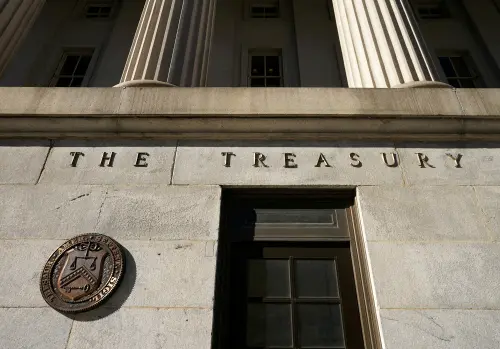Investors are increasingly turning to U.S. Treasuries as a safe haven amid market turmoil driven by President Trump's trade policies. However, the impending debt ceiling debate and ongoing political strife serve as reminders that even the world’s leading risk-free asset can encounter vulnerabilities.
The $28.5 trillion U.S. Treasury market, the largest bond market globally, is recognized for its liquidity and stability, enabling investors to move substantial sums of money swiftly. Nevertheless, several issues may challenge the perception of safety associated with U.S. debt securities.
Foremost among these concerns is the debt ceiling, a self-imposed borrowing limit that requires congressional approval for suspension or increase. The 2023 debt ceiling debate led to a sell-off in stocks and bonds, bringing the U.S. close to default.
Rising debt levels in recent years have weakened the country’s sovereign credit profile, according to Monica Defend, head of Amundi Investment Institute. She notes, "The bigger threat is the possibility of a technical default due to political disputes over the debt ceiling." In 2023, Congress raised the debt ceiling until January 1, 2025, necessitating further action later this year to avert default. Analysts predict that the "X date," when the government could exhaust funds to meet its debt obligations, may fall around July or August.
The recent threat of a government shutdown highlighted the ongoing congressional impasses that have prompted global rating agencies to downgrade the United States’ previously top-tier credit rating. Despite Republican control of Congress, significant political polarization raises concerns, as policy reforms generally require bipartisan consensus, according to a source from a major ratings agency.
A White House spokesperson stated that Trump is dedicated to restoring fiscal credibility. The decline in long-term U.S. interest rates since his return to office on January 20 indicates market confidence in his policies, as evidenced by a reduction in the term premium, which reflects what investors charge for holding long-term debt.
Treasuries have garnered attention recently due to fears of trade disruptions stemming from Trump’s unpredictable tariff strategies, leading investors toward the perceived safety of U.S. government debt. Concurrently, sovereign credit default swaps (CDS), a critical measure of credit risk, have climbed to their highest levels since early November, when the cost of insuring against default began to rise.
"USA CDS spreads tend to trade at very tight levels except during periods of debt ceiling concerns. As of today, the debt ceiling has not been raised," noted Jigar Patel, a strategist at Barclays.
Future rating actions will rely heavily on clarity regarding the U.S. fiscal trajectory, according to the ratings agency source. Republicans are advocating for spending reforms; however, their effect on deficits remains uncertain without significant cuts, which may conflict with Trump's promises to safeguard social programs.
Institutional integrity and governmental checks and balances are also under scrutiny. Attention is particularly focused on the newly formed Department of Government Efficiency (DOGE), led by Elon Musk, aimed at reducing wasteful spending, and how it might shape policy decisions and alter the balance of power within the government.
Moody's is the last major agency to assign the U.S. sovereign debt a top triple-A rating. Meanwhile, Fitch downgraded the rating following a debt ceiling standoff, and S&P Global Ratings has cautioned that rising deficits and political stalemate could pressure its AA+ rating.
An additional risk to the bond market involves the Trump administration's potential willingness to explore unconventional strategies. Some market participants speculate that Trump might use the threat of tariffs and U.S. security alliances to encourage foreign governments to exchange their Treasury holdings for lower-cost long-term bonds.
While the practicalities of such a move remain unclear, it could undermine the confidence of U.S. bondholders, according to Steven Zeng, a U.S. rates strategist at Deutsche Bank.
Trump has sporadically criticized the Federal Reserve, pushing for lower interest rates. Recently, he and Treasury Secretary Scott Bessent have committed to managing the 10-year Treasury yield, a crucial benchmark for the financial system and consumers' borrowing costs.
"If you truly want to keep the 10-year low, you can reinforce credibility," suggested Ben Harris, vice president and director of economic studies at Brookings. He emphasized that this could be accomplished by ensuring the Federal Reserve's independence or through a responsible budgeting process.
"There’s an inconsistency between their stated goals and their policy approach," Harris concluded.
